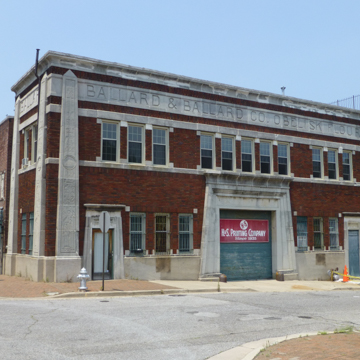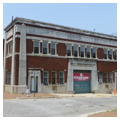You are here
Ballard and Ballard Co. Obelisk Flour Building
The Ballard and Ballard Company was established in Louisville, Kentucky, in 1880 by Samuel and Charles T. Ballard. Their chief product was Obelisk Flour, which they advertised through painted signs that are still visible on the sides of old buildings from Georgia to Maine. The company ceased production under its own name when Pillsbury acquired it in 1951; in 1970 its historic mill in Louisville, supposedly the largest winter wheat flour mill in the world, was destroyed by fire. Thus, the Obelisk Flour Building in Memphis is the most substantial reminder of the Ballard and Ballard Company.
Obelisk Flour is located in the historic South Bluffs Warehouse district. Like most of the surrounding century-old factories and warehouses, the structure is built mostly of brick and the brickwork is notable, not just for the great variety of color, but also for its intricate bonding, especially near the top. Unlike most of the adjacent structures, Obelisk Flour has a deep two-story facade designed in the Egyptian Revival style. Facing Wagner Street, this facade is marked by three canted entrances evoking those of ancient Egyptian temples. The central entrance, a delivery port, is larger than the others and topped with a cast stone lintel incised with an image of the vulture goddess, Nekhbet. The motif was probably lifted from the famous Temple of Ptolemy III at Edfu (begun 237 BCE). Also Egyptian is the cavetto cornice that tops the facade. Pilaster-like cast stone obelisks adorn the corners of the building. Each one contains the Ballard seal at the center with inscrutable hieroglyphs above and below. On both facades the tops of the obelisks flank bold friezes inscribed with the company name.
Though the architect is unknown, the Obelisk Flour was built around 1923–1924, its facade presumably inspired by discovery of King Tutankhamen’s tomb in 1922. Of course, given the flour’s brand name and building’s location in a city with an Egyptian name, the use of the Egyptian Revival style might have been inevitable.
Most of the interior consists of a large, open floor space covered with a flat roof supported by metal, presumably steel, columns. Offices are located in the Egyptian part of the building fronting Wagner Street. Since at least as early as 1986, when it was nominated for the National Register, the building has served as the home of the H and S Printing Company. It is one of the few surviving examples of the Egyptian Revival in the state, and perhaps the only extant commercial building in this style.
References
Carmen Boggs-Parker, “A Guide to the Ballard and Ballard Company Collection, c. 1925.” Special Collections, Virginia Polytechnic Institute and State University, Blacksburg, VA, 2010. Accessed July 31, 2014. http://ead.lib.virginia.edu/vivaxtf/view?docId=vt/viblbv00663.xml.
Jones, Sally, and Bodo, Robin, “South Bluff Warehouse Historic District,” Shelby County, Tennessee. National Register of Historic Places Inventory-Nomination Form, 1986. National Park Service, U.S. Department of the Interior, Washington, DC.
Writing Credits
If SAH Archipedia has been useful to you, please consider supporting it.
SAH Archipedia tells the story of the United States through its buildings, landscapes, and cities. This freely available resource empowers the public with authoritative knowledge that deepens their understanding and appreciation of the built environment. But the Society of Architectural Historians, which created SAH Archipedia with University of Virginia Press, needs your support to maintain the high-caliber research, writing, photography, cartography, editing, design, and programming that make SAH Archipedia a trusted online resource available to all who value the history of place, heritage tourism, and learning.




